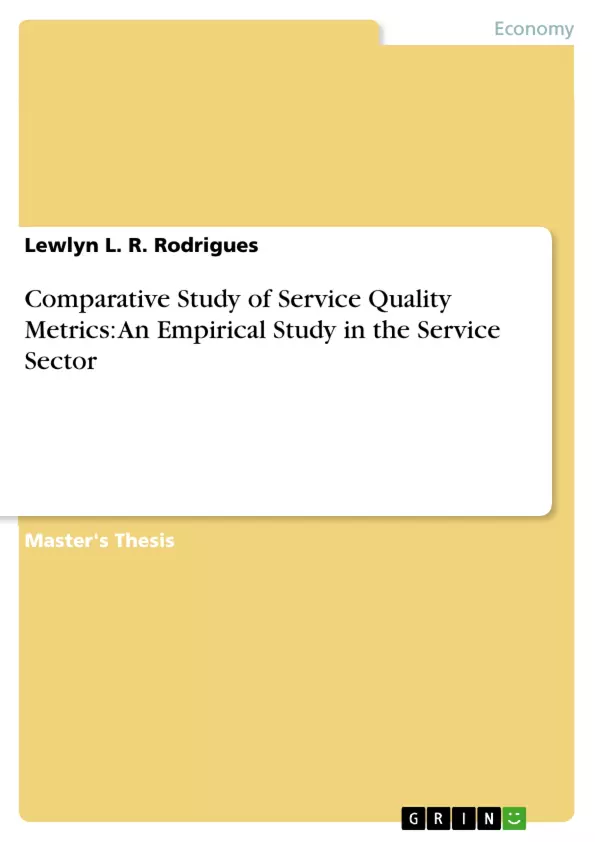The SERVPERF and SERVQUAL are the two Service quality measurement instruments widely used in the measurement of service quality in various service sectors such as banking, hospitals, tourism, insurance etc. But the service quality literature indicates that there exists a significant difference in the philosophy of service quality measurement in these two metrics, and also, the results while these two metrics are used need not necessarily match.
Hence, the problem identified in this research is: do these two metrics concur in their results, or is there a significant difference in their outcomes as applicable to a given service sector. The study also extends to the correlation between the outcomes of these two metrics and looking into the possibility of drawing implications based on the combined outcome.
The research is partly qualitative and partly quantitative in nature. Qualitative in the sense that it analyses existing metrics of service quality based on meta-analysis and, through the use of secondary data, discusses the relative importance of both the metrics in service sectors. The research becomes quantitative, as it deals with descriptive statistics and tests various hypotheses using standard statistical tools. Keviat diagrams have been used to identify the service quality gaps.
The research has clearly indicated that there is a significant difference in the outcomes of SERVQUAL and SERVPERF metrics. The reliability of the study was 0.8815, which is at adequately acceptable level. Tangibles and Reliability are highly scored, and Empathy and Assurance are least scored, whereas, Responsiveness is moderately scored Service quality dimension. It can be concluded that if meaningful outcome has to be obtained, both these metrics have to be applied to a service sector and based on the combined inference drawn, suggestions should be made for quality enhancement.
Inhaltsverzeichnis (Table of Contents)
- Introduction
- Problem Statement
- Research Methodology
- Significance of this Research
- Limitations and Scope for future Research
- Conclusions
Zielsetzung und Themenschwerpunkte (Objectives and Key Themes)
This research aims to determine the correlation and relationship between two widely used service quality measurement instruments, SERVQUAL and SERVPERF, in the context of the service sector. It investigates whether these instruments yield similar or different outcomes in measuring service quality, exploring the possibility of drawing implications based on their combined results.
- Comparison of SERVQUAL and SERVPERF metrics in measuring service quality.
- Correlation and relationship between the outcomes of these two metrics.
- Identification of service quality gaps and their implications for service providers.
- Analysis of the relative importance of tangibles, reliability, empathy, assurance, and responsiveness dimensions in service quality.
- Exploration of the potential for generalization of findings to other service sectors.
Zusammenfassung der Kapitel (Chapter Summaries)
- Introduction: This chapter provides an overview of the significance of service quality measurement in the context of globalization and liberalization, highlighting the emergence of instruments like SERVQUAL and SERVPERF. It introduces the study's focus on examining the correlation and relationship between these two metrics.
- Problem Statement: This chapter outlines the research question, which revolves around the potential differences in outcomes between SERVQUAL and SERVPERF. It examines the philosophical differences between the two metrics and the potential for discrepancies in their results. The chapter also introduces the concept of service quality gaps as defined by SERVQUAL.
- Research Methodology: This chapter outlines the research approach, emphasizing the use of both qualitative and quantitative methods. It describes the use of meta-analysis, secondary data, descriptive statistics, hypothesis testing, and Keviat diagrams in the research process.
- Significance of this Research: This chapter highlights the contribution of the research findings to the body of knowledge in the field of service literature. It summarizes the study's findings regarding the significance of differences in outcomes between SERVQUAL and SERVPERF and the implications for service providers in addressing identified gaps. The chapter emphasizes the importance of utilizing both metrics for quality enhancement.
- Limitations and Scope for future Research: This chapter acknowledges limitations associated with the study's sample size and its focus on a specific higher educational institution. It suggests the potential for future research to generalize findings to a broader context through expanded samples and the application of System Dynamics approach.
Schlüsselwörter (Keywords)
This research focuses on service quality measurement, SERVQUAL, SERVPERF, service quality gaps, tangibles, reliability, empathy, assurance, responsiveness, descriptive statistics, hypothesis testing, meta-analysis, and Keviat diagrams.
- Arbeit zitieren
- Dr. Lewlyn L. R. Rodrigues (Autor:in), 2009, Comparative Study of Service Quality Metrics: An Empirical Study in the Service Sector, München, GRIN Verlag, https://www.grin.com/document/199076



